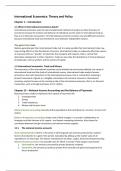International Economics: Theory and Policy
Chapter 1 – Introduction
1.1 What is international economics about?
International economics uses the same fundamental methods of analysis as other branches of
economics because the motives and behavior of individuals are the same in international trade as
they are in domestic transactions. Yet international economics involves new and different concerns
because international trade and investment occur between independent nations.
The gains from trade
Nations generally gain from international trade, but it is quite possible that international trade may
have strong effects on the distribution of income. International trade can adversely affect the owners
of resources that are “specific” to industries that compete with imports, that is, cannot find
alternative employment in other industries. Trade can also alter the distribution of income between
broad groups, such as workers and the owners of capital.
1.2 International economics: Trade and Money
The economics of the international economy can be divided into two broad subfields: the study of
international trade and the study of international money. International trade analysis focuses
primarily on the real transactions in the international economy, that is, transactions involving a
physical movement of goods or a tangible commitment of economic resources. International
monetary analysis focuses on the monetary side of the international economy, that is, on financial
transactions such as foreign purchases of U.S. dollars.
Chapter 13 – National Income Accounting and the Balance of Payments
Macroeconomic analysis emphasizes four aspects of economic life:
1. Unemployment
2. Saving
3. Trade imbalances
4. Money and the price level
National income accounting: Records all the expenditures that contribute to a country’s income and
output.
Balance of payments accounting: Keeps track of both changes in a country’s indebtedness to
foreigners and the fortunes of its export- and import-competing industries. Also shows the
connection between foreign transactions and national money supplies.
13.1 The national income accounts
Gross national product (GNP): is the value of all final goods and services produced by a nation’s
factors of production in a given time period. Calculated by adding up the market value of all
expenditures on final input. The factors of production are labor, capital, land and entrepreneurship.
National income accounts: Four possible uses for which a country’s final output is purchased;
1. Consumption, the amount consumed by private domestic residents.
2. Investment, the amount put aside by private firms to build new plant and equipment for
future production.
, 3. Government purchases, any goods and services purchased by federal, state, or local
governments are classified.
4. Current account balance, the amount of net exports of goods and services to foreigners.
The value of final goods and services produced by home-owned factors of production are counted as
home country’s GNP.
National product and national income
National income (Y): The income earned in that period by its factors of production. GNP must equal
Y, because every dollar used to purchase goods or services automatically ends up in somebody’s
pocket.
Capital depreciation and international transfers
Two adjustments to the definition of GNP must be made before the identification of GNP and
national income is entirely correct in practice:
1. GNP does not take depreciation into account.
2. A country’s income may include gifts from residents of foreign countries, called unilateral
transfers. Net unilateral transfers are part of a country’s income but are not part of its product.
Net national product (NNP): GDP – depreciation + net unilateral transfers.
Gross domestic product
Gross domestic product (GDP): Measures the final value of all goods and services that are produced
within a country in a given time period.
GDP = GNP (produced by a country’s factors of prod.) – payments (from foreign countries) for home
factors of production, but produced abroad (e.g. domestic capital invested abroad) + payments (to
foreign countries) for foreign factors of production, but produced at home (e.g. foreign capital
invested in the NL)
13.2 National income accounting for an open economy
The national income identity for an open economy
In a closed economy: Y = C + I +G
The GNP identity for open economies shows how the national income a country earns by selling its
goods and services is divided between sales to domestic residents and sales to foreign residents.
Open economy: Y = C + I + G + EX - IM.
The current account and foreign indebtedness
Current account balance: The difference between exports of goods and services and imports of
goods and services. CA = EX - IM
Current account deficit: When a country’s imports exceed its exports.
Current account surplus: When its exports exceed its imports.
The current account is important because, since the right-hand side of C + I + G + EX - IM gives total
expenditures on domestic output, changes in the current account can be associated with changes in
output and, thus, employment. Also because it measures the size and direction of international
borrowing.
A country’s current account balance equals the change in its net foreign wealth.
The national income identity says that the CA is also equal to the difference between national
income and domestic residents’ total spending: Y – (C + I + G) = CA.
,It is only by borrowing abroad that a country can have a current account deficit and use more output
than it is currently producing. If it uses less than its output, it has a current account surplus and is
lending to foreigners.
Intemporal trade: International borrowing and lending.
A country with a current account deficit is importing present consumption and exporting future
consumption. A country with a current account surplus is exporting present consumption and
importing future consumption.
Net international investment position (IIP): The difference between its claims on foreigners and its
liabilities to them.
Twin deficit: (T – G) < 0 and (X –M) < 0
Saving and the current account
National saving (S): The portion of output (Y) that is not devoted to household consumption (C) or
government purchases (G).
In a closed economy, national saving always equals investment. Our definition of S tells us that S = Y -
C - G. Since the closed-economy GNP identity, Y = C + I + G, may also be written as I = Y - C - G, then S
= I.
In an open economy, they can differ. Because S = Y - C - G and CA = EX - IM, we can rewrite the GNP
identity as S = I + CA.
(Sp – I) + (T – G) = (X – M)
private public external savings + (gov. budget) = (current account)
surplus surplus surplus
Private and government saving
Private saving: The part of disposable income that is saved rather than consumed. Sp = Y – T – C
Disposable income: Y – T
Government saving: The government’s “income” is net tax revenue (T), while its “consumption” is
government purchases (G). Sg = T – G.
Government budget deficit: To which extent the government is borrowing to finance its
expenditures. G – T
S = Y - C - G = (Y - T - C) + (T - G) = Sp + Sg
S = Sp + Sg = I + CA
Sp = I + CA - Sg = I + CA - (T - G) = I + CA + (G – T)
This equation states that a countries private saving can take three forms:
1. Investment in domestic capital (I)
2. Purchases of wealth form foreigners (CA)
3. Purchases of domestic government’s newly issued debt (G – T)
Beyond the textbook
Ex post national income identity:
• national income = Y = C + I + G + CA = expenditure on domestic production
• Final products not purchased by households or gov. are counted as inventory investment by
firms.
Equilibrium condition in a demand driven model: (not mentioned in book)
• Keynesian Cross
, • Supply = dom. Production = Y = AD (aggregate demand) = C + I + G + CA
(meaning Cdem + Idem + Gdem + EXdem - IMdem)
(dem = demand)
Alternative representation of the national income identity:
• national inc./prod + imports = expenditures at home + abroad (goods/services available
in home country)
• Y + IM = C + I + G + EX
EX-IM has two meanings: (confusing in the book)
• In CA (here): Net expenditure by foreign individuals and institutions
- this includes, for instance, interest payments for debt / foreign capital
• In trade balance: it means exports and imports of goods and services
13.3 The balance of payments accounts
Balance of payments: Flow of all payments for transactions conducted between home country and
rest of the world (RoW). Transactions resulting in a receipt from foreigners -> credit. Transactions
resulting a payment to foreigners -> debit.
Three types of international transactions are recorded in the balance of payments:
1. Transactions that arise from export or import of goods and services and therefore enter directly
into the current account.
2. Transactions that arise from the purchase or sale of financial assets and therefore enter the
financial account.
3. Certain other activities resulting in transfers of wealth between countries are recorded in the
capital account.
Every international transaction automatically enters the balance of payments twice, once as a credit
and once as a debit.
The fundamental balance of payments identity
Current account + capital account = Financial account
The current account
The balance of payments accounts divide exports and imports into three finer categories:
1. Goods, exports or imports from merchandise.
2. Services, payments for legal assistance, tourists’ expenditures and shipping fees.
3. Income, international interest, dividend payments and the earnings of domestically owned
firms operating abroad.
Net unilateral transfers are considered part of the current account as well as a part of national
income, and the identity Y = C + I + G + CA holds exactly if Y is interpreted as GNP plus net transfers.
The capital account
Used to record individual ownership rights of the owners of a company, composed of owner’s capital
contributions made when creating the company or after, as required by business.
The financial account
The difference between acquisitions of assets from foreigners and the buildup of liabilities to them.
Financial derivatives: which are a class of assets that are more complicated than ordinary stocks and
bonds, but have values that can depend on stock and bond values.
Statistical discrepancy






